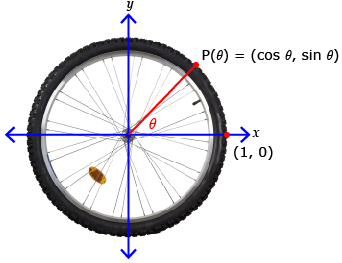Lesson 4 Summary
In this lesson you started with points on the unit circle. At the beginning of the lesson, a reference was made to a bicycle tire rotating though an angle θ with a marker on the tire and a radius of 1 unit. The coordinates of the marker would equal the cosine and sine ratio for the angle θ. Points where the terminal arm of angle θ and the unit circle intersect can be defined as P(θ) = (cos θ, sin θ).
Three reciprocal trigonometric ratios are used in this course.
This means if ![]() then
then
You can use P(θ) = (cos θ, sin θ) to help determine the six trigonometric ratios. So, cos θ = x-coordinate, sin θ = y-coordinate, and ![]() or
or ![]()

iStockphoto/Thinkstock
To determine the trigonometric ratios for a point not on the unit circle, use the coordinates x and y and determine r. When given an angle, you can determine the exact values for trigonometric ratios using the unit circle or reference angles. Your calculator can determine approximate values for trigonometric ratios in the correct mode.
For a summary on the unit circle, you may choose to watch the video Unit Circle Definition of Trig Functions.
